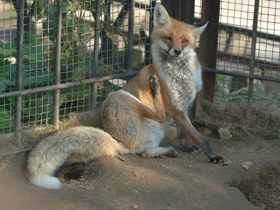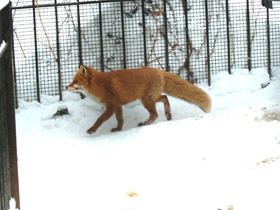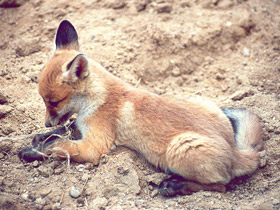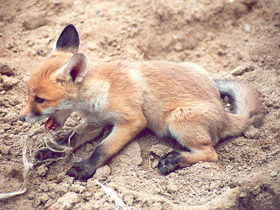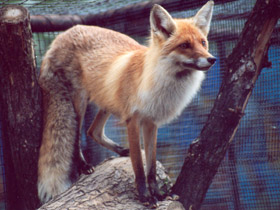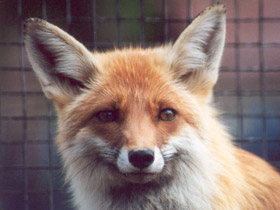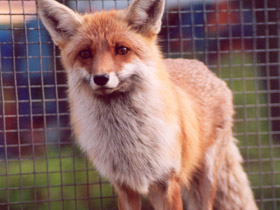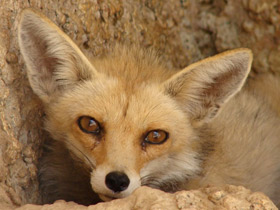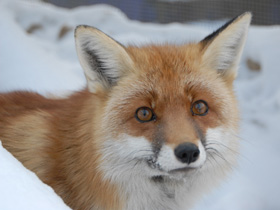The red fox (Vulpes vulpes)
The red fox (Vulpes vulpes) is the largest of the true foxes and one of the most widely distributed members of the order Carnivora, being present across the entire Northern Hemisphere including most of North America, Europe and Asia, plus parts of North Africa. It is listed as least concern on the IUCN Red List. Its range has increased alongside human expansion, having been introduced to Australia, where it is considered harmful to native mammals and bird populations. Due to its presence in Australia, it is included on the list of the "world's 100 worst invasive species".
Нhabitat
Vulpes vulpes is a species of mammal in the family Canidae.
Its scientific name, Vulpes vulpes, is a tautology of the Latin word vulpes, meaning "fox".
The common fox is such a wide-ranging species that it is the most plastic member of the predator family. Foxes inhabit all landscapes and geographic zones, from tundra and subarctic forests to steppes and deserts to mountain ranges in all climatic zones. These ubiquitous predators can be found not only in the wild, but also in man-made landscapes, even on the outskirts of cities, including some as large as Kiev and Warsaw. In London, foxes are fairly common on the outskirts, and occasionally appear in the city centre, where they inhabit rubbish dumps, parks and house basements. Although they may scavenge food from humans like stray dogs, wherever they are hunted they are wary and excel at hiding and deception, making foxes the epitome of cunning and agility in much of folklore.
Hunting and feeding
The common fox is a typical polyphagous predator, able to exploit any available prey in a given area and to use a variety of hunting methods. The range of food consumed includes approximately 300 species of animals, from small ungulates, rabbits, hares, rodents, reptiles and birds to invertebrates such as locust beetles and earthworms. During the ripening season, blueberries, apples and rose hips may constitute 90% of the fox's diet, and several dozen other plants are also eaten. However, small rodents, mainly voles, make up the diet of the common fox. Unlike wolves, foxes hunt alone.
Mouse hunting The common fox is poetically described by biologist and cynologist V. Gusev: "The fiery beauty is marvellous against the background of sparkling snow. The little fiery beauty trots cautiously, stopping from time to time with its head held high, from time to time catching the scents of the snow. The subtlest squeak of a mouse causes the huntress to swerve sharply and here she creeps cautiously, having located her prey several dozen metres away. For a moment, the fox freezes, listening, then leaps several times to strike the snow with all four paws, and suddenly twists in the air as if diving into the snow to capture its bewildered prey."
Reproduction
The common fox is monogamous, breeding once a year, with 1 to 6 cubs in a litter. Males are actively involved in raising the cubs. If the father dies, another bachelor takes his place and sometimes foxes even fight each other to become the stepfather.
When the cubs are born, the father and mother are extremely cautious and immediately move them to a reserve den if they are threatened.
The cubs grow rapidly. At two weeks of age, they open their eyes and the mother dares to leave them behind during hunting trips.
From four weeks of age, the cubs join their parents at the entrance of the den, where they play for a long time.
The mother feeds the cubs milk for a month and a half, and the parents gradually train them to eat and retrieve food.
At six weeks of age, the cubs go on their first independent hunts near the den, hunting insects, mice and sometimes even chicks.
Day by day, they become more agile, cautious and independent. At 6 months, the cubs finally leave the burrow, but their parents continue to feed them on their prey until the end of the summer.
By autumn, the cubs have grown up and can live on their own.
Terminology
Males are called tods or dogs, females are called vixens, and young are known as cubs or kits. Although the Arctic fox has a small native population in northern Scandinavia, and while the corsac fox's range extends into European Russia, the red fox is the only fox native to Western Europe, and so is simply called "the fox" in colloquial British English.
Etymology
The word "fox" comes from Old English, which derived from Proto-Germanic *fuhsaz. Compare with West Frisian foks, Dutch vos, and German Fuchs. This, in turn, derives from Proto-Indo-European *puḱ- 'thick-haired; tail'. Compare to the Hindi pū̃ch 'tail', Tocharian B päkā 'tail; chowrie', and Lithuanian paustìs 'fur'. The bushy tail also forms the basis for the fox's Welsh name, llwynog, literally 'bushy', from llwyn 'bush'. Likewise, Portuguese: raposa from rabo 'tail', Lithuanian uodẽgis from uodegà 'tail', and Ojibwe waagosh from waa, which refers to the up and down "bounce" or flickering of an animal or its tail.
The scientific term vulpes derives from the Latin word for fox, and gives the adjectives vulpine and vulpecular.
Subspecies
The 3rd edition of Mammal Species of the World listed 45 subspecies as valid. In 2010, a distinct 46th subspecies, the Sacramento Valley red fox (Vulpes vulpes patwin), which inhabits the grasslands of the Sacramento Valley, was identified through mitochondrial haplotype studies. Castello (2018) recognized 30 subspecies of the Old World red fox and nine subspecies of the North American red fox as valid.
Substantial gene pool mixing between different subspecies is known; British red foxes have crossbred extensively with red foxes imported from Germany, France, Belgium, Sardinia and possibly Siberia and Scandinavia. However, genetic studies suggest very little differences between red foxes sampled across Europe. Lack of genetic diversity is consistent with the red fox being a highly agile species, with one red fox covering 320 km (200 mi) in under a year's time.
Red fox subspecies in Eurasia and North Africa are divided into two categories:
- Northern foxes are large and brightly coloured.
- Southern grey desert foxes include the Asian subspecies Vulpes vulpes griffithi, Vulpes vulpes pusilla, and Vulpes vulpes flavescens. These foxes display transitional features between the northern foxes and other, smaller fox species; their skulls possess more primitive, neotenous traits than the northern foxes and they are much smaller; the maximum sizes attained by southern grey desert foxes are invariably less than the average sizes of northern foxes. Their limbs are also longer and their ears larger.
Red foxes living in Middle Asia show physical traits intermediate to the northern foxes and southern grey desert foxes.
Subspecies
Forty-five subspecies of Vulpes vulpes are known.
- Vulpes vulpes vulpes vulpes;
- Vulpes vulpes abietorum;
- Vulpes vulpes alascensis;
- Vulpes vulpes alpherakyi;
- Vulpes vulpes anatolica;
- Vulpes vulpes vulpes arabica;
- Vulpes vulpes vulpes atlantica;
- Vulpes vulpes bangsi;
- Vulpes vulpes barbara;
- Vulpes vulpes beringiana;
- Vulpes vulpes cascadensis;
- Vulpes vulpes caucasica;
- Vulpes vulpes crucigera;
- Vulpes vulpes daurica;
- Vulpes vulpes deletrix;
- Vulpes vulpes dolichocrania;
- Vulpes vulpes dorsalis;
- Vulpes vulpes flavescens;
- Vulpes vulpes fulvus;
- Vulpes vulpes griffithi;
- Vulpes vulpes harrimani;
- Vulpes vulpes hoole;
- Vulpes vulpes ichnusae;
- Vulpes vulpes indutus;
- Vulpes vulpes jakutensis;
- Vulpes vulpes vulpes japonica;
- Vulpes vulpes karagan;
- Vulpes vulpes kenaiensis;
- Vulpes vulpes kurdistanica;
- Vulpes vulpes macroura;
- Vulpes vulpes vulpes montana;
- Vulpes vulpes necator;
- Vulpes vulpes niloticus;
- Vulpes vulpes ochroxantha;
- Vulpes vulpes palaestina;
- Vulpes vulpes peculiosa;
- Vulpes vulpes pusilla;
- Vulpes vulpes regalis;
- Vulpes vulpes rubricosa;
- Vulpes vulpes schrenckii;
- Vulpes vulpes silacea (the Iberian);
- Vulpes vulpes splendidissima;
- Vulpes vulpes stepensis;
- Vulpes vulpes tobolica;
- Vulpes vulpes tschiliensis.
Karaganka fox (Vulpes vulpes karagan)
Karaganka fox (Vulpes vulpes karagan) is a subspecies of carnivorous mammals in the family Canidae. Vulpes vulpes karagan is common south of the range of the forms described above. It is characterised by a light yellow-ochre colouration, with no melanistic individuals. These Vulpes vulpes karagan inhabit southern Transbaikalia, the Mongolian People's Republic, Kazakhstan and Tien Shan, as far south as Ferghana. In this area, several forms have been described which apparently can be combined into one subspecies, which has its western limit of distribution in the south of the transural region.
The coat is coarse, dull, grey or yellowish; there is a mixture of brownish shades on the back. The ears are longer than those of the northern forms; the overall size, on average, is somewhat smaller.
Arabian red fox (Vulpes vulpes arabica)
Arabian red fox (Vulpes vulpes arabica) is a subspecies of carnivorous mammals in the family Canidae. Vulpes vulpes arabica is a subspecies common in Arabia, Syria, Jordan, Israel, Saudi Arabia and Yemen. These foxes live in a wide variety of habitats: they can be found in mountains and coastal areas, in deserts, as well as in human settlements (including urban areas).
Their coat colour is similar to that of the common red fox, but they are better adapted to desert habitats. The ears of Vulpes vulpes arabica are much larger than those of the common fox and the body is smaller. It grows fur between its toes, which helps it to avoid burning its paws. Vulpes vulpes arabica weighs between 2.7 and 4.5 kg.
The Vulpes vulpes arabica is a solitary fox and each animal has its own territory which it defends from other foxes. They feed mainly on rodents and birds, occasionally on fish and carrion.
They are mainly active at night.
Vulpes vulpes arabica cubs open their eyes at 10 days of age.











